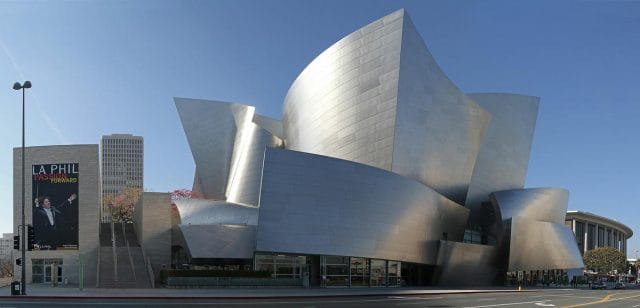
The Walt Disney Concert Hall in Los Angeles, designed by Frank Gehry
Frank Gehry, architect of the Guggenheim Museum in Bilbao, the Walt Disney Concert Hall in Los Angeles, and Fondation Louis Vuitton in Paris, thinks with his hands. He makes architectural models by tearing scraps of paper, gluing and taping them together, crinkling cardboard, and adding apples and Perrier bottles.
The problem is that these gestural shapes are challenging to construct as actual, stable architecture. They also tend to be very expensive to build. For sheet materials such as glass or metal, a unit with double curvature (for example, shaped like a saddle or dome) can cost up to five times as much as one curved in a single direction (for example, shaped like a cone or cylinder), which, in turn, can cost up to five times as much as the flat material. Flattening and standardizing a design saves money–but for projects whose aesthetic impact stems from complex geometries, orthogonal and regular forms just won’t do.
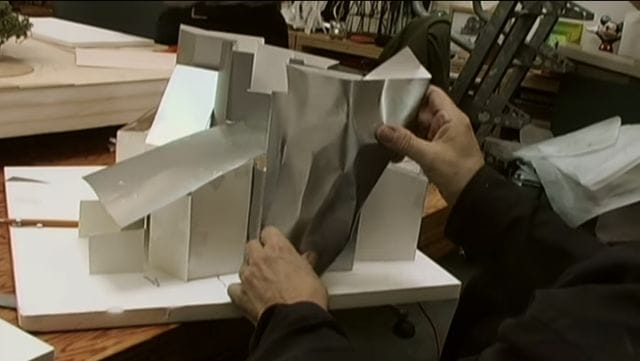
Gehry wrangles a piece of cardboard in the 2012 documentary Sketches of Frank Gehry
In our post-Gehry era, prominent architects often design buildings that seem unbuildable. This is where Gehry Technologies comes in.
The first generation of architecture and engineering software was developed in the late 1970s. It allowed designers to draw via the computer instead of on paper. But the results were still just drawings. In the 1990s, Frank Gehry pioneered a second generation of “smart” digital design in architecture, by using software to optimize designs and translate them directly into a process of fabrication and construction.
Now known in the industry as parametric design and building information modeling, this approach has ushered in a new era of architecture, according to art historian Irene Nero: the era of “technological construction.” And Gehry Technologies drove this innovation, even though Gehry himself “speaks with a certain degree of pride in his inability to operate a computer,” as CTO Dennis Shelden observed in his MIT doctoral dissertation.
How did an architect who doesn’t use computers start a technology company?
Building a Fish
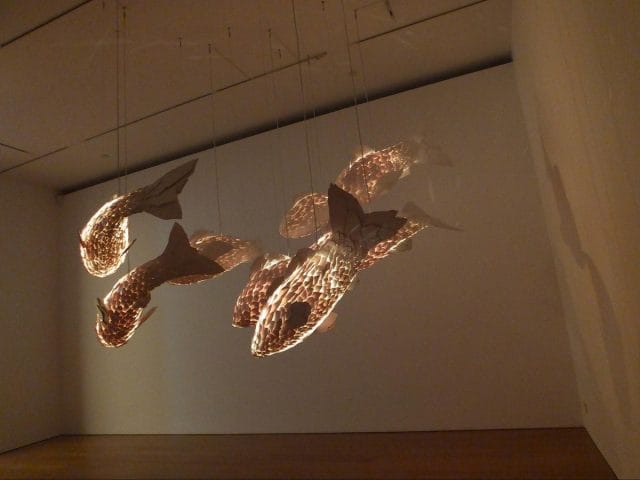
Frank Gehry’s continued interest in fish resulted in a new set of lamps in 2013; Source: Maureen Didde
When he was a child, Gehry’s grandmother took him to a Jewish market in Toronto to buy live carp to make gefilte fish. “She’d put it in the bathtub,” he has said, “fill the bathtub with water, and this big black carp—two or three feet long—would swim around in the bathtub and I would play with it. I would stand up there and watch it turn and twist…”
By the early 1980s, Gehry had been running his firm for 20 years and had achieved international fame after his 1978 deconstructivist renovation of his own home. Still, the image of writhing carp continued to enchant him, and he started building fish-shaped lamps. When Gehry won a contract for a pavilion for Barcelona’s 1992 Olympics, he designed a 50 meter mesh sculpture in the form of an undulating fish.
His team then had to figure out how it would be built. They were working with flat materials — sheets of stainless steel mesh. They had to figure out how to cut the sheets into shapes that, when curved, would assume the correct dimensions without buckling. Working from the firm’s 2D construction drawings, a contractor tried and failed six times to create a mock-up.

CATIA version 3, in 1988
Jim Glymph, Gehry’s “office hippie,” turned to a program called CATIA, a C++ software package developed by an aerospace manufacturer. The manufacturer, Dassault Systems, first used it in 1977 to design the Mirage fighter jet.

A 3D Bézier surface with control points
CATIA described digital models using parametric Bézier curves (or vectors) and 3D surface algorithms. The model is defined by a set of control points and the mathematical functions, or surfaces, that stretch between them. The parameters of these functions can be freely adjusted, making a Bézier surface accurate at any scale — unlike other software Glymph had tried. IBM loaned four $130,000 workstations to Gehry’s office to complete the work using CATIA, and within six months the Barcelona Fish was built, on budget.
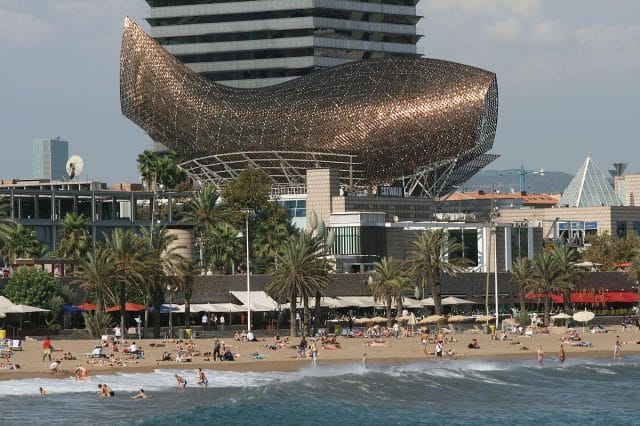
A New Kind of Building
Meanwhile, Gehry had been struggling with a larger project: the Walt Disney Concert Hall in Los Angeles. Based on the success of the Barcelona Fish, he turned to CATIA. Gehry’s firm used a CATIA model to minimize the number of stone panels with custom — and therefore expensive — complex curves. As the design evolved, each element was drawn and redrawn in 2D. In 1994, contractors’ bids based on these drawings came back at $180M. This was double the target budget, and for a major public project, it was a scandal. Los Angeles Magazine ran a story called “Taking the Fall: Is the Disney Hall Fiasco Really Frank Gehry’s Fault?”
Fortunately, Gehry had also won the contract to design a new Guggenheim Museum in a sleepy Spanish town called Bilbao, and was able to start testing his hard-won wisdom in a new experiment. As usual, Gehry designed the Guggenheim Bilbao using physical models. Then, instead of recreating the models on the computer by hand, the team scanned the models’ x, y, and z coordinates with a digitizing wand. Once imported into CATIA, this data was resolved into parametric surfaces that Gehry’s designers could digitally manipulate to optimize for design and constructability.
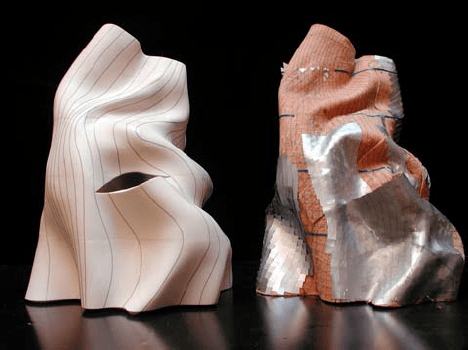
Example of original physical model (right) and a model of the same design, after it’s been digitally rationalized (left); Source: Shelden, 2002
By this point, the firm had internalized a few rules of thumb: “flat is cheaper than bent (60% of the walls stayed flat); bent is cheaper than cut; machine-cut is cheaper than hand-cut.” They also had a heuristic for estimating how far a metal sheet might bend without wrinkles: “if a sheet of paper can do it, so can a contractor.”
The team simultaneously pioneered a new, more integrated organizational model. Executing a major architectural work requires the collaboration of hundreds of individuals from different disciplines, across dozens of firms. Materials, costs, and schedules have to be orchestrated in a global, years-long process of fabrication, transportation, and construction. While these distributed teams might best operate as “networked organizations,” as Dennis Shelden, CTO of Gehry Technology, has written, they are “contractually constricted from functioning in this manner.”
For example, when an architecture firm produces 2D construction drawings, they’re typically printed out and delivered to the contractor as part of a legal contract that defines where the architect’s liability ends, and the contractor’s begins. Contractors then translate the architect’s drawings into their own “shop” drawings that are checked against the architect’s construction drawings before being used for fabrication.
Gehry suspected that digitally designed geometries could be executed much more efficiently with less redundancy. Instead of creating standard 2D construction drawings, Gehry now had his contractors refer directly to the 3D digital model, translating digitized coordinates directly into manual cutting instructions and machine tooling paths.
The contractors he worked with welcomed his guidance. “Most contractors,” has since said, “want the architect to be the Daddy.” In 1997, the museum opened on budget and on time to rave reviews.

Gehry returned again to the Disney Hall project with new techniques and renewed confidence. As he has described, “the computer demystifies the building to such a degree of accuracy that builders know exactly what they’re building…It leads to fewer mistakes and a better-organized process.” When Disney Hall opened in 2003, it was lauded as a triumph.
Training the Competition
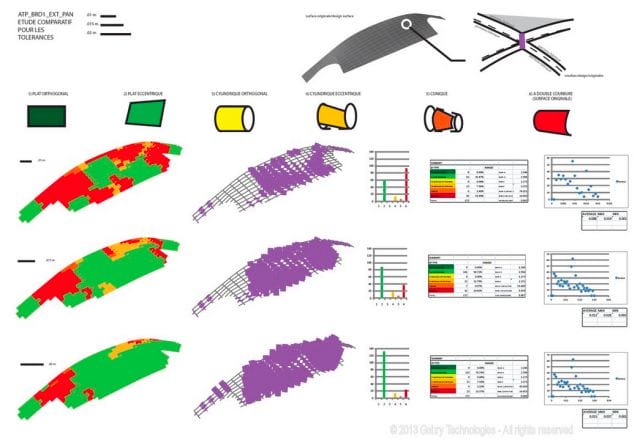
Gehry Technologies: optimizing an architectural design by minimizing panels with complex curvature in favor of single and zero (flat) curvatures
Gehry realized that being an architect who knew how to “be the Daddy” on a project was not only a competitive advantage, but also a new business model that could transform the industry. In 2002 he and his employees Jim Glyph and Dennis Shelden spun off Gehry Technologies, to help spread their expertise and tools. “I am training the competition,” Gehry has said of the company.
In a recent interview with Priceonomics, Shelden explained Gehry Technology’s original intention: “If few can work in this new way, the cost of working with other people is high. By bringing the industry forward, you help your competitors but you also help your partners, ultimately letting you do better work at a lower price.”
Shelden has observed that “historically, information was expensive and materials and energy were cheap. Now the cost of information is going down, and the cost of materials and energy is going up.” Today, this “cheap” information can save “about 10% the cost of a building’s construction,” so it’s big business.
Over the years, Gehry Technologies has sold both software and professional services, allowing each to inform the other. Initially, they just resold CATIA, and offered training and configuration for architects. But they quickly realized that they needed architecture-related features not offered by CATIA, such as support for plumbing and construction scheduling. So they partnered with Dessault Systems, the aerospace manufacturers who made CATIA, to develop an architecture-specific version of the software called Digital Project.
Gehry Technologies also launched a comprehensive project delivery service. For a fee, Gehry Technologies manages the process of transforming other architects’ designs into buildings. Their projects include Diller Scofidio + Renfro’s Alice Tully Hall at the Lincoln Center in New York, Herzog + de Meuron’s “Bird’s Nest” stadium for the 2008 Beijing Olympics, and the entrance hall for Skidmore, Owings + Merrill’s Burj Khalifa tower in Dubai (currently the world’s tallest building).
These services helped drive Gehry Technologies’ growth–a “25 percent year over year increase” in both 2010 and 2011–while also informing their software development. They gained insight into how other firms operate, and where technology could make the biggest impact. One of their biggest recent innovations has been to develop tools to help architecture and building teams organize themselves and communicate about a project.

Digital Project Model for the Beijing Olympics stadium designed by Herzog + de Meuron
In 2009, while working on the Fondation Louis Vuitton building in Paris, Gehry Technologies began to develop the project-based collaboration platform called GTeam (now Trimble Connect). They needed a way to support “federated” data, in which databases from different vendors appear to work as one while functioning autonomously. At the same time, they were “excited about social media,” according to Shelden, and about the prospect of fluidly collaborating across firms, time zones, and schedules.
Like a mix of GitHub, Google Docs, and Facebook, but for design and construction, GTeam allows collaborators to simultaneously edit different models within a project. The implications of each edit automatically propagate throughout, while the software checks for conflicts. Given the financial and legal structures that conventionally discourage architects, engineers, and contractors from sharing information so freely, the software also logs each move for legal record-keeping. Leading architecture firms including Zaha Hadid, Greg Lynn, UNStudio, Moshe Safdie, and Coop Himmelb(l)au have used this platform.
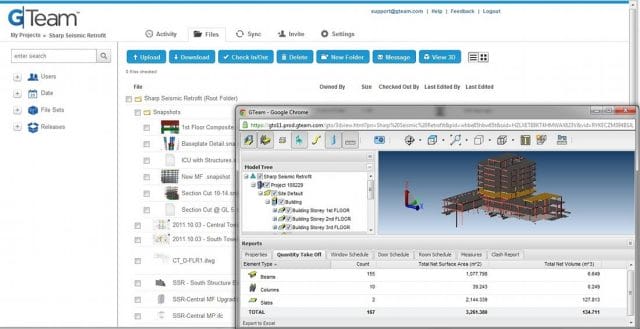
Screenshot of GTeam
In September 2014, the 140-person Gehry Technologies first spun off Digital Project, their version of the software CATIA, as a separate company. Then the rest of Gehry Technologies — including GTeam and the firm’s project delivery services — was acquired for an undisclosed sum by Trimble Navigation. Trimble provides GPS, logistics, and asset management technologies to the agriculture, construction, engineering, and transportation sectors, to the tune of over $2.6B in annual revenue. The purchase was part of a several-year-long shopping spree by Trimble, which now also owns the user-friendly 3D modeller Sketchup and facility management software Manhattan Atrium.
The merger has combined Gehry Technologies’ expertise in design and construction with Trimble’s interests in supply chains, logistics, and facility management. While the publicly-traded company is tight-lipped about its ambitions, one small sign of things to come arrived in April 2015, when Trimble announced that it was bringing Microsoft’s holographic augmented reality goggles, known as HoloLens, to a market that it tellingly describes as “AEC-O,” or architecture, engineering, construction, and operations.
Meanwhile, Frank Gehry has come full circle as an architect. In April 2015, his architecture firm completed the design of Facebook’s new Silicon Valley headquarters. Mark Zuckerberg commented that Frank “said we should go get other bids and that he would beat them all — and he did. As I learned, most building construction wastes a lot of materials and time due to poor planning. Frank has designed special software to assist in his architecture, so he’s very efficient.”
This post was written by contributor Lian Chang. To get occasional notifications when we write blog posts, please sign up for our email list.



